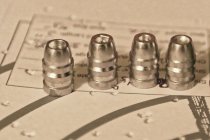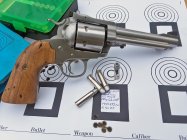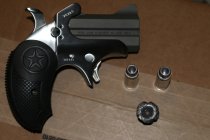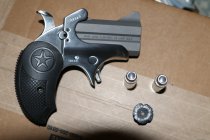You are using an out of date browser. It may not display this or other websites correctly.
You should upgrade or use an alternative browser.
You should upgrade or use an alternative browser.
Go easy on me; I haven't cast in ~7 years
- Thread starter Adam in WI
- Start date
JSH
Gold $$ Contributor
2200?Nice looking boolits.
If you want to remove zinc, you can flux with a tablespoon of copper sulfate crystals.
The blue crystals will turn white as the zinc is exchanged with copper, then the zinc sulfate crystals are easily skimmed off the top. In my experience, copper in the melt doesn't affect the pour.
Flux: I keep my pot clean, use clean ingots, and don't run it too hot. When my melt is ready, I will remove dross using a steel slotted spoon and do it occasionally as I add sprues or ingot pieces. I don't worry any more about the oxide skin that forms. I've tried oil, crayons, paraffin, kitty litter, and saw dust. Wax and oil stopped the skin forming, but the smoke (and flames) was unacceptable. Sawdust and kitty litter - what a friggin mess. Plus, it's just more crud to spoon off. I never tried lime, as I didn't think it would provide any added benefit.
Modern wheel weights:
A neighbor kid gave me an eighty pound bucket of wheel weights from his work. I took an average sample batch and slowly heated them in my mold kiln up to 2200°F. There was some zinc, less than 20%, some iron (magnetic), but it seemed there was a lot of manganese, as these oxidized to a blackish color as I heated. I didn't check what I deemed as manganese for weak magnetism to confirm, was satisfied with the visual.
Where does lead start to boil and gas?
What does that high of a temp achieve?
I have been away from my casting for a couple of years, but I know extra high temps and the gas is what will get ya sick.
JSH
Gold $$ Contributor
Wow, I am sure glad I have about two life times supply of alloys! All the crap and garbage you guys are having to contend with sounds like a royal PITA.Not all zinc will float. Some are mixed with other stuff and will melt at the same temperatures lead melts at. That's why you should try to use the cutting method. Be very careful of the copper mix. If you get too much it is worse than zinc.
I feel very fortunate to have gathered, smelted and labeled around two tons, WW, plumbers lead, roof sheathing, Lino and mono type, solder from a radiator shop and a fair bit of tin along with some antimony. Gent I shot with for many moons sold a buddy and I his stash.
I read some place a while back there were folks using zinc to cast with? Seems awful hard.
JSH
Gold $$ Contributor
I believe you and I along with some others have exchanged findings and thoughts on CB’s. I have wondered off the path and shooting “full length gas checks” a lot the past few years. I swore I would never cast for smaller than a 30, ate those words and 22,6,6.5 was a new learning curve to some extent."Less is more".... old 2 stroke M/C reference concerning fuel-oil ratios.
Some may not want to accept it but,well.... OK,don't. Less velocity/pressure needs "more" lube than jacked up rifle loads. If I used any less lube on my bughole varmint rigs.... it would be none. On the edge of 3k fps and only lube is either JUST the tiny space above GC,or that and one groove.
It's almost exactly like adj a paint spray gun. At handgun velocity/pressure... the lube is being sucked out of the groove,and is why commercial hard lubes are so bad.
Turn up the "volume" in a shouldered,high intensity rifle case.... there ain't any sucking or wicking haha. That chit is being blown WELL ahead of the bullet. So,less lube is doing WAY more work. It gets into hydraulics and a bunch of theory that,like obcessing over BHN numbers,is bogging the caster down IMO. You want to run the least amount of lube,and the lowest BHN that gets the job done.... running "more" isn't just some kind of safety factor. In cast,it actually hurts performance.
Like the "fit" of the bullet.... Goldilocks and the 3 bears. Too small,too large,and what we want... just right. Same with lube and alloy properties.
Playing with 17 and 20 calibers, I know there are molds out there, but I am to much of a speed freak.
Your 3K in a 22 interest me, I need to catch up on a favorite passion it sounds like ;-).
Not done exploring the limits JSH....
Here's a shot of the Lyman 450's. Beam style on left is ridiculously repeatable on seeing to around,+ - 5-10 inch pounds,what a rifle bullet will "take" before it slumps.
There's some other uses too. Anyway,after you check a new batch for slump,then go to the clicker style to set GC's and any top punch effected bumping.
There's just too much to write about on a forum.... a good one is bumping noses up on bore rides(no biggy in of itself) to where they "gimble" in the fit. Think of a raised section just behind the ogive.... that gets done with the clicker style but also utilizes custom H die. The key to it is the "hump" or bump.... you pull on sizer handle waiting for the click,at exactly the same time the bullet base passes through the H die leade.
Making H dies,and nose dies really opened my eyes to how cast interfaces with the chamber leade. On some of my nose dies;
They're say 1 1/4" mild steel round rod an inch or so long. Chuck it up and take a clean up cut off OD. Then drill and taper ream the through hole. No biggy with all this,takes longer to write. BUT,in use.... getting the bullet nose to align is checked by rolling the die on a flat plate. Doing this,you can experiment with that particular bullet,and it's ability to self align. Just like an H die. Different taper angles see this alignment gain or lose precision. Same dang thing happens in the chamber. So saying you "have" to run X degrees of taper on bore rides,or that this ogive has to have this much jam is only as accurate a statement as your tests prove. Yes,there are some generalizations but this ain't horseshoes.

Here's a shot of the Lyman 450's. Beam style on left is ridiculously repeatable on seeing to around,+ - 5-10 inch pounds,what a rifle bullet will "take" before it slumps.
There's some other uses too. Anyway,after you check a new batch for slump,then go to the clicker style to set GC's and any top punch effected bumping.
There's just too much to write about on a forum.... a good one is bumping noses up on bore rides(no biggy in of itself) to where they "gimble" in the fit. Think of a raised section just behind the ogive.... that gets done with the clicker style but also utilizes custom H die. The key to it is the "hump" or bump.... you pull on sizer handle waiting for the click,at exactly the same time the bullet base passes through the H die leade.
Making H dies,and nose dies really opened my eyes to how cast interfaces with the chamber leade. On some of my nose dies;
They're say 1 1/4" mild steel round rod an inch or so long. Chuck it up and take a clean up cut off OD. Then drill and taper ream the through hole. No biggy with all this,takes longer to write. BUT,in use.... getting the bullet nose to align is checked by rolling the die on a flat plate. Doing this,you can experiment with that particular bullet,and it's ability to self align. Just like an H die. Different taper angles see this alignment gain or lose precision. Same dang thing happens in the chamber. So saying you "have" to run X degrees of taper on bore rides,or that this ogive has to have this much jam is only as accurate a statement as your tests prove. Yes,there are some generalizations but this ain't horseshoes.

wildcatter
Silver $$ Contributor
Casting and the 45 Colt Blackhawk is my main handgun hunting platform for decades! Mine is properly throated, very important to having 6 different chambers shooting the same from on gun!
I shoot cast for the simple reason it is
MORE ACCURATE THAN JACKETS!
IT IS GIVES MORE VELOCITY THAN THE SAME WEIGHT JACKET,,,, WITH LESS PRESSURE!
AND IM LAZY! I NEVER CLEAN MY BARREL ONCE SEASONED WITH CAST!
I have proven these facts for over 4 decades since I got my first Blackhawk! Plus if you read the " writings of John Linebaugh" you will find ge totally agrees! That's where my experience starts!
I think your pouring to hard of bullets for best results! I would mix 8 pounds ww to 2 pounds pure lead, it will create a better seal.
I also add 1/4 pound of 99% tin bulion to my 20 pound pot. The tin does not harden, it coats the bullet,,,(eliminates the frosting look ), plus it toughens the bullet and will keep it from fragmenting,,, makes them tougher by increasing elasticity!

I run a 270 grain Keith hp from a mihec mold to 1400 fps and never lead my barrel using xx grains of H110,,, a safe Linebaugh load in the Blackhawk and Redhawks, not safe in other revolvers aside from the BFR and 83 FA. four different point configurations with the ability to pour a solid nose.
I also Use the Mihec HP in a 180 grain Carbine mold for my 357 Bisley, over 1450 fps, again no loading, and some excellent accuracy for these old eyes and using the same alloy! It is my go to for high velocity magnum handgun loads, HP or solid. Hard on deer out to 100 yards.

Slow em down arond 950 fps and then I mix it 50/50 and skip the tin bulion. but that 270 grain out of my Bond gives excellent terminal performance, recovered from water jugs at 15 yards.
![20171114_094823[1].jpg 20171114_094823[1].jpg](https://forum.accurateshooter.com/data/attachments/468/468741-04c37632c492f4994f7ec0dd383e0d47.jpg?hash=BMN2MsSS9J)
recovered from sand.

More people create leading issues from to hard of alloy in revolvers, the base of the bullet has bump up to properly seal. Even with proper sized for throats, that base needs to seal and to hard a bullet won't let it swell under pressure to seal properly! The less pressure, the softer that base needs to be! and the Tin Bullion is what makes consistent finish, and even weight even, and wont harden your alloy.
I also water drop from my mold all the time. It gives the best hardening when arsenic is present from your ww alloy. Like others said, today be carefull with wheel weights, it only takes a couple zink and the alloy is destroyed. But never would I give up performance using Jacketed bullets in any revolver I own, even my 454 and 480 gets premium slugs,,,,,, lead!
I shoot cast for the simple reason it is
MORE ACCURATE THAN JACKETS!
IT IS GIVES MORE VELOCITY THAN THE SAME WEIGHT JACKET,,,, WITH LESS PRESSURE!
AND IM LAZY! I NEVER CLEAN MY BARREL ONCE SEASONED WITH CAST!
I have proven these facts for over 4 decades since I got my first Blackhawk! Plus if you read the " writings of John Linebaugh" you will find ge totally agrees! That's where my experience starts!
I think your pouring to hard of bullets for best results! I would mix 8 pounds ww to 2 pounds pure lead, it will create a better seal.
I also add 1/4 pound of 99% tin bulion to my 20 pound pot. The tin does not harden, it coats the bullet,,,(eliminates the frosting look ), plus it toughens the bullet and will keep it from fragmenting,,, makes them tougher by increasing elasticity!

I run a 270 grain Keith hp from a mihec mold to 1400 fps and never lead my barrel using xx grains of H110,,, a safe Linebaugh load in the Blackhawk and Redhawks, not safe in other revolvers aside from the BFR and 83 FA. four different point configurations with the ability to pour a solid nose.
I also Use the Mihec HP in a 180 grain Carbine mold for my 357 Bisley, over 1450 fps, again no loading, and some excellent accuracy for these old eyes and using the same alloy! It is my go to for high velocity magnum handgun loads, HP or solid. Hard on deer out to 100 yards.

Slow em down arond 950 fps and then I mix it 50/50 and skip the tin bulion. but that 270 grain out of my Bond gives excellent terminal performance, recovered from water jugs at 15 yards.
![20171114_094823[1].jpg 20171114_094823[1].jpg](https://forum.accurateshooter.com/data/attachments/468/468741-04c37632c492f4994f7ec0dd383e0d47.jpg?hash=BMN2MsSS9J)
recovered from sand.

More people create leading issues from to hard of alloy in revolvers, the base of the bullet has bump up to properly seal. Even with proper sized for throats, that base needs to seal and to hard a bullet won't let it swell under pressure to seal properly! The less pressure, the softer that base needs to be! and the Tin Bullion is what makes consistent finish, and even weight even, and wont harden your alloy.
I also water drop from my mold all the time. It gives the best hardening when arsenic is present from your ww alloy. Like others said, today be carefull with wheel weights, it only takes a couple zink and the alloy is destroyed. But never would I give up performance using Jacketed bullets in any revolver I own, even my 454 and 480 gets premium slugs,,,,,, lead!
Attachments
Nice post. Love your Bisley!
Both zinc and lead will boil below 2000°F, but I was pouring off any molten material every few hundred degrees. Open the kiln, grab the crucible with tongs, pour any liquid out into a RCBS ingot mold. I basically got two 1 lb ingots cast with what looked like zinc. I didn't bother with Archimedes principle tests to see if it was, in fact, zinc.2200?
Where does lead start to boil and gas?
What does that high of a temp achieve?
I have been away from my casting for a couple of years, but I know extra high temps and the gas is what will get ya sick.
An old gentleman warned me of that. I've never used more than 1/4 cup of copper sulfate, and I did not notice any fill-out problems with the mold.Be very careful of the copper mix. If you get too much it is worse than zinc.
The galvanized look is normal. The lead cools from the outside first then cools and solidifies inward. It's the appearance of the lead grain structure.I got fed up trying to find bullets of the right size or hardness for my .45 Blackhawk, so I ordered a 280 grain brass mould from NOE. Tonight I tried it out on about 50 bullets and this is how they turned out. I smoked the mould and pre heated it. Alloy is straight wheel weights air cooled. Some of them have a sort of galvanized look around the noses. They're not frosty like overheated lead. The majority filled out good, and the few that I checked were within 1.2 grains weight. View attachment 1409045
View attachment 1409046
View attachment 1409047
JSH
Gold $$ Contributor
More people create leading issues from to hard of alloy in revolvers, the base of the bullet has bump up to properly seal. Even with proper sized for throats, that base needs to seal and to hard a bullet won't let it swell under pressure to seal properly! The less pressure, the softer that base needs to be! and the Tin Bullion is what makes consistent finish, and even weight even, and wont harden your alloy.
It’s not just revolvers. For years I had hard alloy shoved in my face every time leading was in a discussion. My shooting bud and found proved several locals wrong. We softened our alloy and it all came together very nicely. We did the same with some rifle loads with better success.
Hard lead even Lino will skid and strip, then only get worse until it is cleaned and removed.
Seasoned barrels, won’t get any argument from me! Some claim to swap back and forth from jacketed to cast with no issue. I did a few times, left me with gremlins.
wildcatter
Silver $$ Contributor
Yep, I've never seen anything but problems changing from jackets to lead without starting with a scrubbed barrel. But the way lead outperforms jackets in revolvers, it baffles me why anyone would even handicap themselves using jackets. But when you mix them without prepping for each, the outcome is never optimum!Seasoned barrels, won’t get any argument from me! Some claim to swap back and forth from jacketed to cast with no issue. I did a few times, left me with gremlins.
Unless going after moderate velocity in rifle loads I really don't see that lead is a better choice, but below 2100 to 2500 fps, I think lead is a better choice. Their is an advantage to both lead and copper, same as their is an advantage to a partition bullet for hunting to a spitzer, today we have the ability and resources to reap the most from our gear thankfully.
When I cast, it was mostly the longer rifle bullets. At the time, the most prolific author on cast bullets for that application did actual experiments, standing in a depression and shooting edgewise into the layer of snow. This allowed him to collect bullets that had not been deformed by impact. What he found was that for best accuracy that you wanted a combination of strength and pressure that slightly swelled the bullet, measured at the bottom of the lube grooves. If the pressure was too high, the bullet would have a curved in its longitudinal axis of mass (degrading accuracy), and if it was too hard (straight linotype) the accuracy was not as good. I also seem to remember reading that even for pistol bullets that you do not want bullets that are too hard to seal the bore, that gas blow by was a problem for leading. The neatest trick that I ran across for plain base pistol bullets were polyethylene sheet discs that were set in case mouths and pushed in by the bullet as it was seated. I made some, after reading about the ones that NECO used to offer. I just looked on the site and apparently they no longer do. The ones that I made were punched out with a sharpened fired .357 (cutting on soft wood end grain) case out of 1/16" thick sheet of either HDPE or LDPE (I forget). I placed them in the flared mouths of the cases just before seating bullets. I tried them for a heavy pistol bullet, and they did a good job of minimizing lead fouling in my pistol's barrel.
AckleymanII
Gold $$ Contributor
I put a lyman thermoter in my pot, it never leaves. I cast between certain temps to keep the weight constant.
OP. you need a tad bit of tin in your mix, you will love your results.
If you notice some leading, up your size a tad, add a little linotype to your mix. .001 over bore dia should be a great place to start.
OP. you need a tad bit of tin in your mix, you will love your results.
If you notice some leading, up your size a tad, add a little linotype to your mix. .001 over bore dia should be a great place to start.
I had a copy of the NRA Lead casting book. I bought it about 1975. I gave it to someone at the range. I see it sells on E-Bay now for about $50.I put a lyman thermoter in my pot, it never leaves. I cast between certain temps to keep the weight constant.
OP. you need a tad bit of tin in your mix, you will love your results.
If you notice some leading, up your size a tad, add a little linotype to your mix. .001 over bore dia should be a great place to start.
wildcatter
Silver $$ Contributor
Here is a great place for cast info,I had a copy of the NRA Lead casting book. I bought it about 1975. I gave it to someone at the range. I see it sells on E-Bay now for about $50.
Cast bullet alloy's and bullet obturation
From the pages of The IHMSA News, Shooting sports, hand gun, ammo, cartridges, xp 100, reloading, firearm, cast bullet, bullet casting and more information articles
www.lasc.us
I had a discussion with John in the custom shop at FA years ago, and he confirmed that most of the throat erosion and gas cutting on model 83 revolvers was from pushing Jacketed bullets at max pressures in the 454 Casual, especially those under 300 grains chasing speed.Last jacketed we shot was through a couple of brand new FA’s. Ran a couple hundred, then on to cast and never look back. Worst mistake of my life, waiting till I was 40 something to get my first FA.
His claim was also that cast bullets over 300 grain was what made the 454 everything it could be. I found this to be true in my guns as well. I prefer a 340 grain, and had a custom mold made by Dan at Mountain molds years ago.
Last edited:
Upgrades & Donations
This Forum's expenses are primarily paid by member contributions. You can upgrade your Forum membership in seconds. Gold and Silver members get unlimited FREE classifieds for one year. Gold members can upload custom avatars.

Click Upgrade Membership Button ABOVE to get Gold or Silver Status.
You can also donate any amount, large or small, with the button below. Include your Forum Name in the PayPal Notes field.
To DONATE by CHECK, or make a recurring donation, CLICK HERE to learn how.

Click Upgrade Membership Button ABOVE to get Gold or Silver Status.
You can also donate any amount, large or small, with the button below. Include your Forum Name in the PayPal Notes field.
To DONATE by CHECK, or make a recurring donation, CLICK HERE to learn how.










